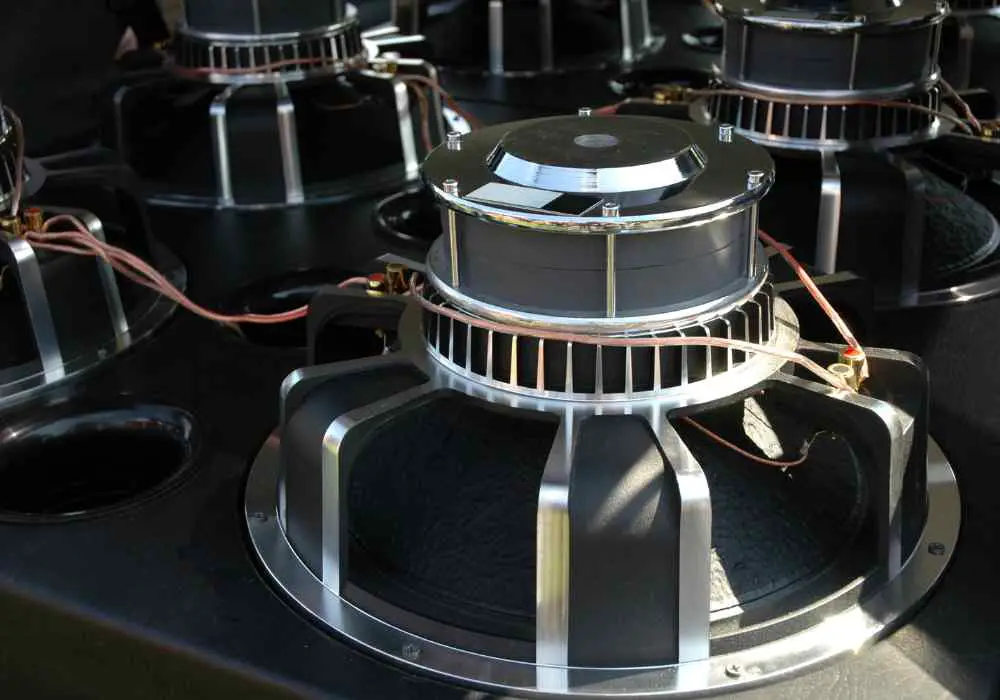Car audio enthusiasts know that a subwoofer is an essential component in creating a high-quality sound system.
A subwoofer is a speaker specifically designed to produce low-frequency sounds, also known as bass.

These sounds are not easily produced by regular car speakers, and that’s why a subwoofer is needed to supplement and enhance the overall audio experience.
In this article, we will guide you through the process of setting up a subwoofer in your car for optimal sound quality.
Equipment Needed for Subwoofer Installation:
Before we begin, it’s important to have the necessary equipment on hand.
The first and most obvious is a subwoofer and an amplifier. The subwoofer is responsible for producing the bass, and the amplifier is what powers the subwoofer.
Together, they work to enhance and amplify the low-frequency sounds.

In addition to the subwoofer and amplifier, you will also need a wiring kit and installation accessories such as speaker wire, RCA cables, and a fuse holder. These items will be used to connect the subwoofer and amplifier to the car’s electrical system.
You will also need basic tools such as screwdrivers, wire cutters, and a drill to complete the installation process.
Choosing a Location for the Subwoofer:
The next step is to choose a location for the subwoofer. When selecting a location, consider factors such as space, accessibility, and the desired sound quality.
The most common locations for a subwoofer include the trunk, back seat or under the driver or passenger seat.
Some people prefer a trunk installation as it allows for more space and better sound quality. Others prefer a back seat installation as it is more accessible and easier to install.
When installing a subwoofer in the trunk, you will need to ensure that the subwoofer box is properly sealed to prevent sound leakage into the cabin.
Additionally, the space in the trunk should be sufficient to accommodate the subwoofer box.
When installing a subwoofer under the seat, you will need to ensure that there is enough room for the subwoofer and amplifier and that the installation will not interfere with the seat adjustment mechanism.
Once you have chosen a location for the subwoofer, you can begin the process of wiring the subwoofer and amplifier.
Wiring the Subwoofer and Amplifier:
The process of wiring the subwoofer and amplifier can be complex, but with the right instructions and a little patience, it can be done.
Start by connecting the subwoofer to the amplifier using the speaker wire.
Be sure to connect the positive wire of the subwoofer to the positive terminal of the amplifier and the negative wire of the subwoofer to the negative terminal of the amplifier.
Next, connect the amplifier to the car’s electrical system using the RCA cables and the fuse holder.
The RCA cables are responsible for sending the audio signal from the car’s head unit to the amplifier.
The fuse holder is used to protect the amplifier from power surges.
Once the subwoofer and amplifier are connected, you can begin the process of routing and grounding the wires.
To ensure that the installation is clean and professional, it’s essential to route the wires in a way that keeps them hidden and out of the way.
Grounding the wires is also important. Grounding the wires helps to reduce noise and interference in the audio system.
It’s essential to ground the wires at a solid metal surface, such as the car’s frame.
Tuning the Subwoofer for Optimal Sound:
Once the subwoofer and amplifier are installed and wired, the final step is to tune the subwoofer for optimal sound.
This process involves adjusting the gain, crossover, and EQ settings on the amplifier.
The gain controls the amount of power that is sent to the subwoofer.
It’s essential to set the gain correctly to prevent distortion and damage to the subwoofer.
To set the gain, play music at a moderate volume and gradually increase the gain until you hear distortion.
Then, reduce the gain slightly until the distortion disappears.
The crossover is a filter that separates the low-frequency sounds that are sent to the subwoofer from the high-frequency sounds that are sent to the other speakers.
The crossover settings can be adjusted to tailor the subwoofer’s performance to the car’s acoustics. To set the crossover, play music with a good bass response and adjust the crossover frequency until you achieve the desired bass response.
The EQ, or equalizer, is a tool that allows you to fine-tune the subwoofer’s sound by adjusting the levels of different frequencies.
To set the EQ, play music with a good bass response and adjust the EQ settings until you achieve the desired bass response.
Conclusion:
In this article, we have outlined the steps to set up a subwoofer in a car for optimal sound quality.
We have discussed the importance of proper subwoofer setup and the equipment needed for the installation.
We have also provided detailed instructions for choosing a location, wiring the subwoofer and amplifier, and tuning the subwoofer for optimal sound. By following these steps, you can enjoy a high-quality sound system in your car.
As a final note, it’s important to remember that subwoofer installation can be complex, and if you are unsure about any aspect of the process, it’s best to seek professional help.
Additionally, if you want to make sure that you have done a proper installation, you can always take your car to a professional to have the installation checked and fine-tuned.
Additional Resources:
- For further learning and troubleshooting, you can refer to the manual of your subwoofer and amplifier or consult online forums for car audio enthusiasts.
- Additionally, you can consult professional installers or car audio shops for advice and assistance with subwoofer installation.
By following these steps and using the right equipment and techniques, you will be able to set up a subwoofer in your car for optimal sound quality and enjoy a high-quality sound system in your car.
Can I install a subwoofer in my car myself or do I need a professional?
While it is possible to install a subwoofer in your car yourself, it is a complex process that requires a certain level of technical knowledge and expertise.
It’s recommended that you seek professional help if you are unsure about any aspect of the installation process.
How do I properly match the subwoofer impedance?
The impedance of a subwoofer is measured in ohms and is the amount of electrical resistance that the subwoofer presents to the amplifier.
To properly match the subwoofer impedance, you need to match the impedance of the subwoofer with the impedance of the amplifier.
Most subwoofers have an impedance of 4 ohms, but some subwoofers have 2 or 8 ohms.
Make sure to check the specifications of your subwoofer and amplifier and match the impedance accordingly.
What is the phase of the subwoofer and how do I set it correctly?
The phase of a subwoofer refers to the timing of the sound waves that the subwoofer produces.
To set the phase correctly, you need to match the phase of the subwoofer with the phase of the other speakers in your car audio system.
Most amplifiers have a switch that allows you to adjust the phase of the subwoofer. You can set the phase by playing music and adjusting the switch until you achieve the best bass response.
How do I properly seal the subwoofer box?
A sealed subwoofer box, also known as an acoustic suspension enclosure, is designed to enhance the bass response of the subwoofer.
To properly seal the subwoofer box, you need to use a sealant such as silicone to fill any gaps or openings in the box.
This will prevent sound leakage and ensure that the bass response is optimal.
How do I properly choose the right size and power of the amplifier?
Choosing the right size and power of the amplifier is crucial for the performance of the subwoofer.
The size of the amplifier should match the size of the subwoofer and the power of the amplifier should match the power of the subwoofer.
As a general rule, it is recommended to choose an amplifier that can deliver at least twice the power of the subwoofer.
Additionally, you should check the specifications of your subwoofer and amplifier and match the power and size accordingly.
